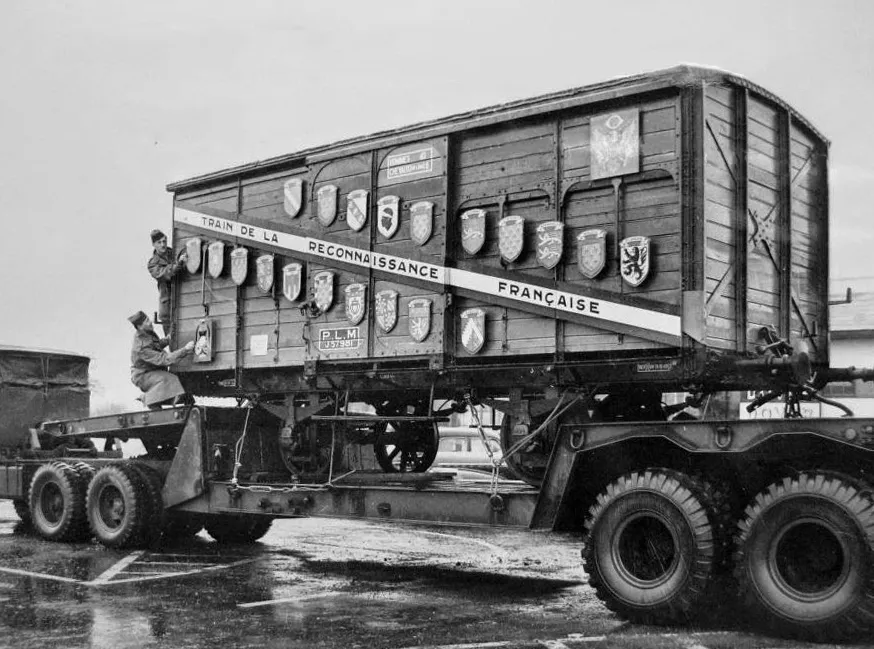
WWW.SMITHSONIANMAG.COM
Long-Lost 'Merci Train' Given to New Jersey After World War II Has Been Found
Cool Finds
Long-Lost ‘Merci Train’ Given to New Jersey After World War II Has Been Found
To thank America for its support during the war, France sent a boxcar stuffed with gifts to each state. But in the late 1950s, New Jersey’s disappeared without a trace
The boxcar was part of the Merci Train, which France gave to the United States in 1949.
United Railroad Historical Society of New Jersey
In 1949, France assembled an elaborate gift to thank the United States for its support during World War II. It was known as the “Merci Train,” a locomotive with 49 small boxcars—one for each state at the time, plus one for Washington, D.C. and the territory of Hawaii to share—filled to the brim with presents.
But about a decade later, the boxcar presented to New Jersey disappeared. Historians previously thought it may have been destroyed, though they couldn’t find any records to piece together its fate.
Now, however, the state’s long-lost gift from France has been found. It’s slated to return home to New Jersey this spring, reports NorthJersey.com’s David M. Zimmer.
The boxcar sat in storage at the National World War I Museum and Memorial in Kansas City for 30 years.
United Railroad Historical Society of New Jersey
“It’s rare for something that’s this big and this important to disappear and then reappear,” Kevin Phalon, executive director of the United Railroad Historical Society of New Jersey, the nonprofit that plans to restore and preserve the boxcar, tells NBC New York’s Adam Harding.
“Items like this don’t just pop up—it’s literally like finding buried treasure,” he adds.
The Merci Train’s story begins in 1947, when the United States sent a “Friendship Train” to France in the aftermath of World War II. The Friendship Train was full of donated food, and it was primarily meant to be a symbol of goodwill between the two nations.
It's not clear what happened to the boxcar after it disappeared.
United Railroad Historical Society of New Jersey
Two years later, France reciprocated with the 49-car Merci Train. Built between 1893 and 1895, the Merci Train boxcars were originally used to transport soldiers and supplies during World War I. They were known as “40 and 8” cars because they had room for either 40 men or 8 horses. Before the journey across the Atlantic, French citizens packed them with gifts and mementos.
After the Merci Train touched down on American soil, the boxcars were dispersed to states throughout the nation. New Jersey’s arrived in Trenton at a ceremony led by Governor Alfred Driscoll, according to the historical society. Afterward, the boxcar went on tour, and the gifts from French citizens were distributed around the state.
The boxcar eventually ended up in the possession of a veterans’ society on Long Island, as NJ.com’s A.J. McDougall reports. The group was a chapter of the Society of 40 Men and 8 Horses—a nod to the Merci Train boxcars’ original use—but no one knows how or why New Jersey’s boxcar ended up in New York. Whatever the reason, it went missing around 1958.
In 1993, the boxcar was found in a field in Tennessee.
United Railroad Historical Society of New Jersey
Then, in 1993, curators with the National World War I Museum and Memorial found a weathered Merci Train boxcar of unknown origins in a field in Tennessee. They transported it to Kansas City, Missouri, where the museum is located. It sat in museum storage for three decades.
Last year, Chris Juergens, a curator at the museum, decided to get to the bottom of the boxcar mystery. He worked with historian David Knutson to match the boxcar’s metal serial plates to archival photographs of the boxcar from New Jersey.
Once they confirmed the boxcar’s identity, museum officials decided to donate it to the United Railroad Historical Society of New Jersey so that it could return to its home state.
Historians matched the metal serial plates on the boxcar with those in archival photographs.
United Railroad Historical Society of New Jersey
The historical society is raising money to transport the boxcar to New Jersey. Once it arrives—likely this month or early next month—experts are planning to complete a full restoration, Phalon tells Smithsonian magazine. The boxcar’s exterior will return to its 1949 appearance, while the interior will be renovated to house a traveling exhibition about the Merci Train and the railroad’s role in both world wars more broadly.
They also hope to get the boxcar listed on the New Jersey Register of Historic Places. If all goes to plan, the project will be complete by the spring of 2027.
It may look worn, but the boxcar is in fairly good shape, according to the historical society. It’s structurally sound, with its steel frame intact, and it still has some of its original wood.
The boxcar still has its steel frame and some of its original wood.
United Railroad Historical Society of New Jersey
Additionally, the historical society isn’t the first organization to restore a Merci Train boxcar. Other groups have conducted similar renovations, and they’ve agreed to share their techniques.
Once the preservation work is complete, the historical society wants to “pick up where the [boxcar’s] story left off,” Phalon tells NJ.com.
“We want to move it around and bring it places,” he adds. “The state fair, parades, air shows. It’s a unique opportunity.”
Get the latest stories in your inbox every weekday.
0 Reacties
0 aandelen
70 Views


